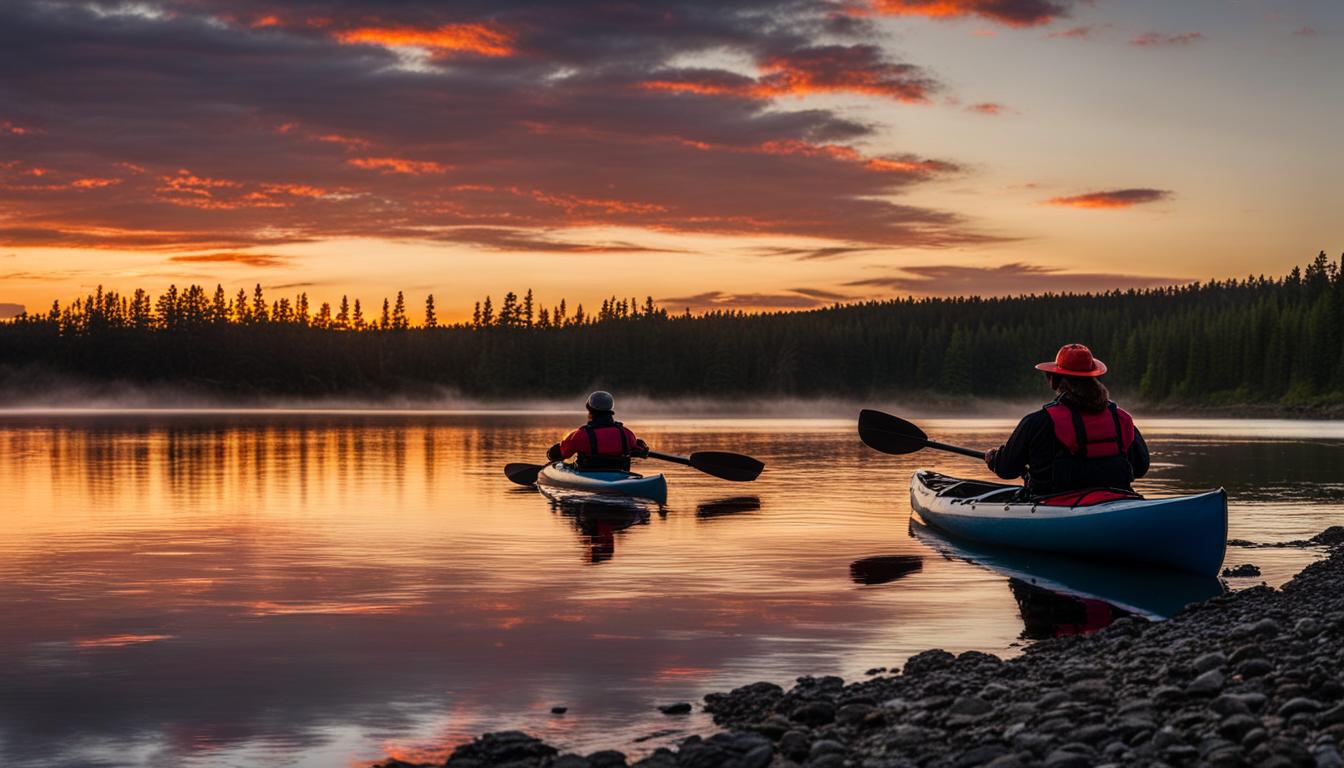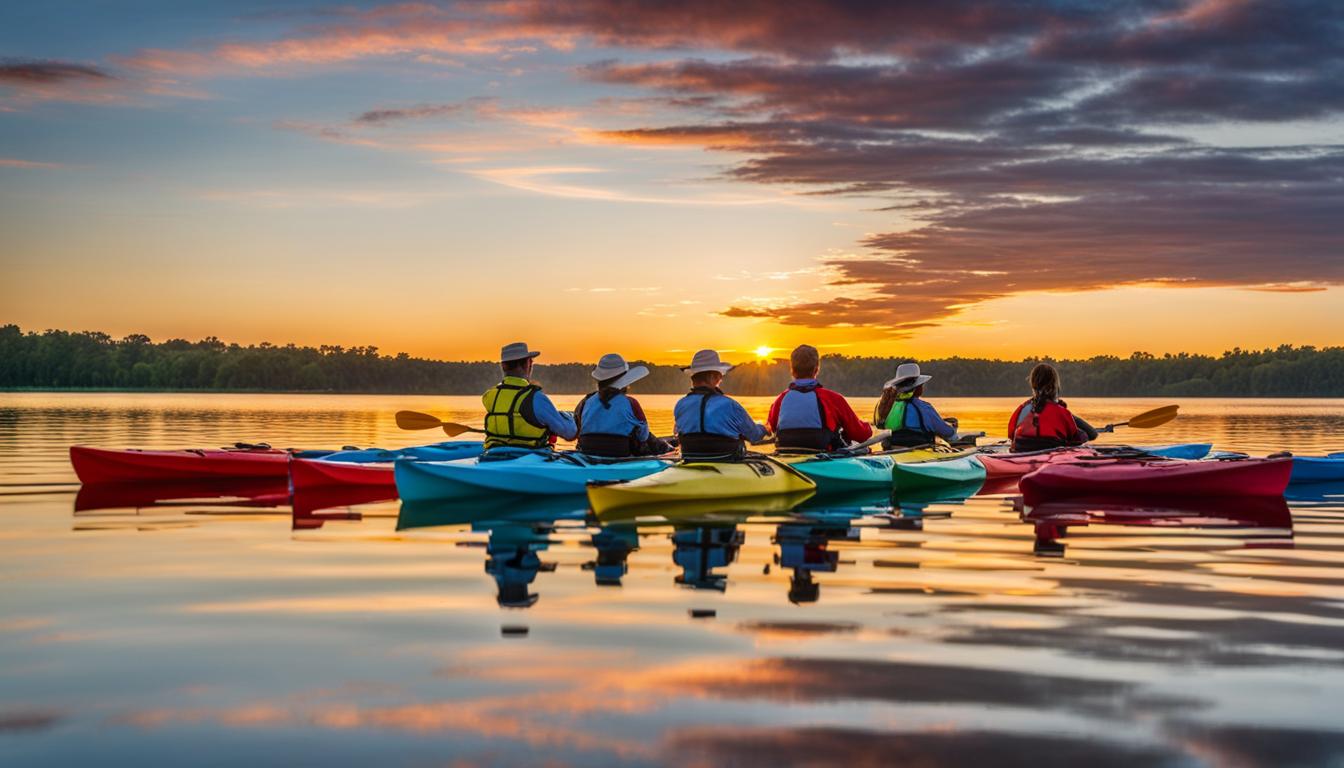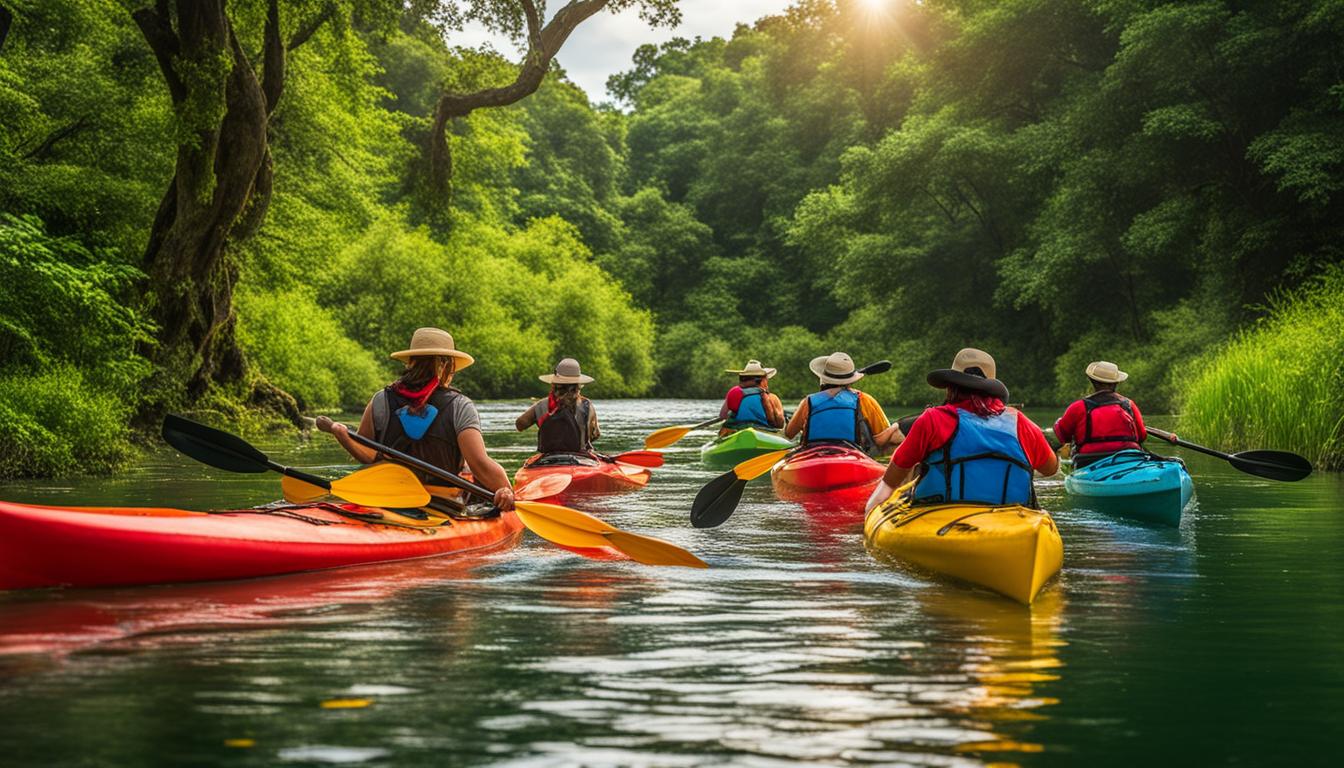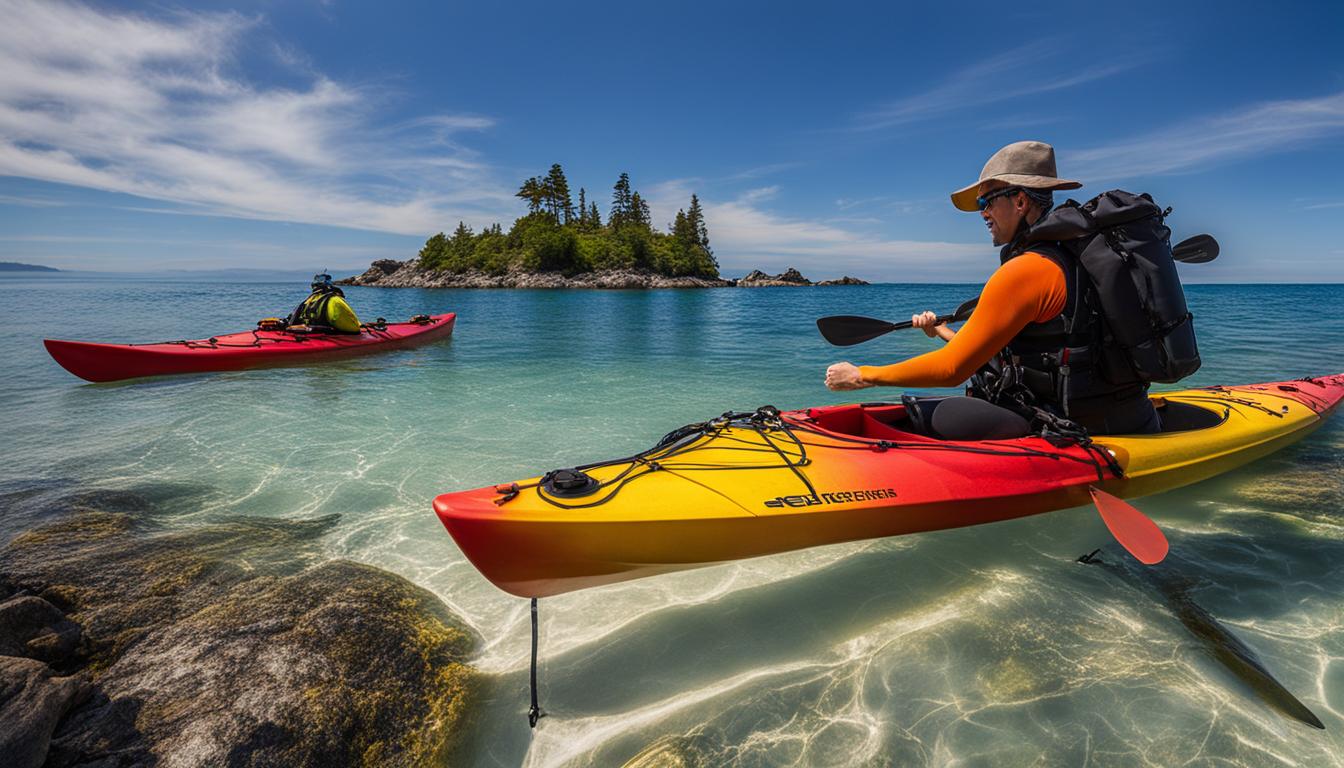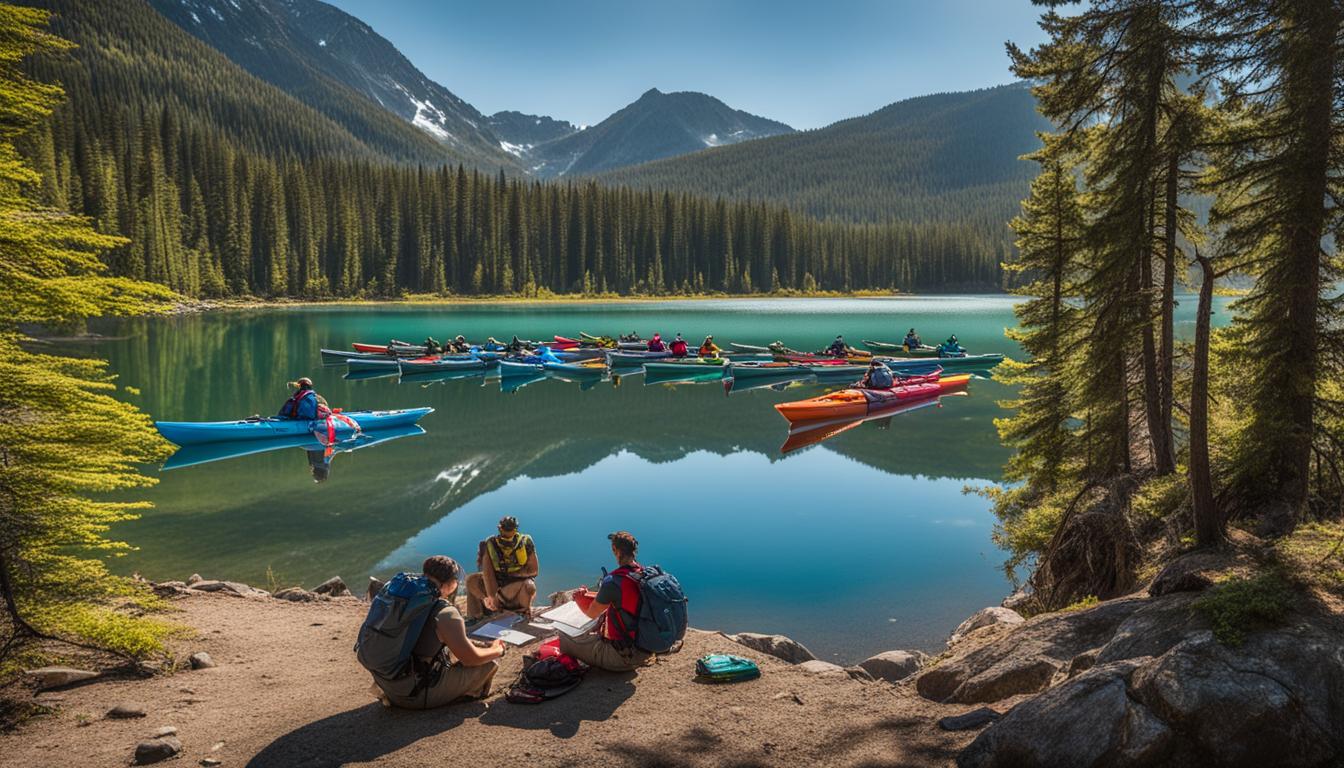Are you planning a kayak camping trip and wondering whether to go solo or camp with a group? Both options have their own unique advantages and considerations. In this article, we’ll explore the benefits of solo kayak camping and the advantages of group kayak camping, helping you make an informed decision based on your preferences and goals.
Key Takeaways:
- Solo kayak camping offers independence, solitude, and opportunities for self-reflection and personal growth.
- Group kayak camping provides a sense of community, shared experiences, and added safety and support.
- Consider factors like the type of kayak, trip planning, and safety precautions when choosing between solo or group camping.
- Recreational, touring, fishing, and tandem kayaks are different types suited for solo and group camping.
- Solo kayak camping requires additional safety gear and self-reliance, while group camping allows for shared responsibilities and resources.
Choosing the Right Kayak for Your Needs
When planning a solo or group kayak camping trip, one of the most important considerations is choosing the right kayak. The type of kayak you choose will greatly impact your experience on the water and the overall success of your camping adventure. Here are some key factors to consider:
Solo vs Group Kayak Trip Planning
Before selecting a kayak, think about whether you will be paddling alone or with a group. Solo kayakers may prioritize factors such as maneuverability and ease of handling, as they will be solely responsible for navigating the kayak. Group campers, on the other hand, may prioritize stability and storage capacity, as they will need to accommodate the needs of multiple individuals.
Sit-on-Top vs Sit-In Kayaks
Another important decision is choosing between a sit-on-top or sit-in kayak. Sit-on-top kayaks are more popular for recreational use and are generally more stable and easier to get in and out of. They also provide ample storage space for camping gear. Sit-in kayaks, on the other hand, offer better protection from the elements and are ideal for colder climates or rougher water conditions. They provide a more traditional kayaking experience but may have limited storage space.
Kayak Weight and Budget
The weight and budget of the kayak are also important considerations. Heavier kayaks may be more difficult to transport and maneuver, particularly for solo paddlers. It’s important to consider your own strength and capabilities when choosing a kayak. Additionally, consider your budget and look for a kayak that offers a good balance between price and quality, ensuring you get the most value for your investment.
Shape and Size Considerations
The shape and size of the kayak will also impact its performance and handling. Longer kayaks tend to be faster and track better, making them suitable for longer trips and open-water paddling. Shorter kayaks, on the other hand, are more maneuverable and easier to turn, making them ideal for navigating narrow waterways or rocky areas. The width of the kayak will also affect its stability, with wider kayaks providing more stability but sacrificing speed.
By considering these factors and finding the right balance between your personal preferences and the demands of your camping trip, you can choose a kayak that will ensure a comfortable and enjoyable experience on the water.
| Factors | Solo Kayak Camping | Group Kayak Camping |
|---|---|---|
| Solo vs Group | Prioritize maneuverability and ease of handling | Prioritize stability and storage capacity |
| Sit-on-Top vs Sit-In | More popular for recreational use, easier to get in and out of | Offer better protection from the elements |
| Kayak Weight | Consider your own strength and capabilities | Consider the needs of multiple individuals |
| Budget | Look for a good balance between price and quality | Consider the budget of the group |
| Shape and Size | Consider maneuverability and ease of turning | Consider stability and storage space |
Types of Kayaks for Solo and Group Camping
When it comes to kayak camping, choosing the right type of kayak is essential for a successful and enjoyable experience. There are different types of kayaks available, each designed to cater to specific needs and preferences. Whether you plan to go solo or camp with a group, understanding the different types of kayaks can help you make an informed decision. Let’s take a closer look at some of the most popular types of kayaks for solo and group camping:
Recreational Kayaks
Recreational kayaks are a popular choice for casual paddlers who want to enjoy calm lakes and rivers. These kayaks are typically wide and stable, making them easy to maneuver and ideal for beginners. They often have a spacious cockpit for comfortable seating, and some models come with additional storage compartments to keep your gear easily accessible.
Touring Kayaks
If you’re planning longer trips and need a kayak with ample storage space, touring kayaks are the way to go. These kayaks are designed with efficiency and stability in mind, allowing you to cover greater distances with ease. They often feature a sleek, narrow design with a V-shaped hull, providing excellent tracking and maneuverability.
Fishing Kayaks
For those who enjoy fishing, fishing kayaks are specifically designed to cater to your needs. These kayaks come equipped with features such as rod holders, tackle storage, and built-in mounts for accessories like fish finders. They are typically stable and offer a comfortable seating position, allowing you to spend hours on the water without any discomfort.
Tandem Kayaks
If you prefer camping with a group, tandem kayaks are a great option. These kayaks are built for two or more people, offering ample space for both paddlers. They provide increased stability and are ideal for beginners who may not have much kayaking experience. Tandem kayaks can be a fun and social way to explore the water while sharing the experience with a companion or loved ones.
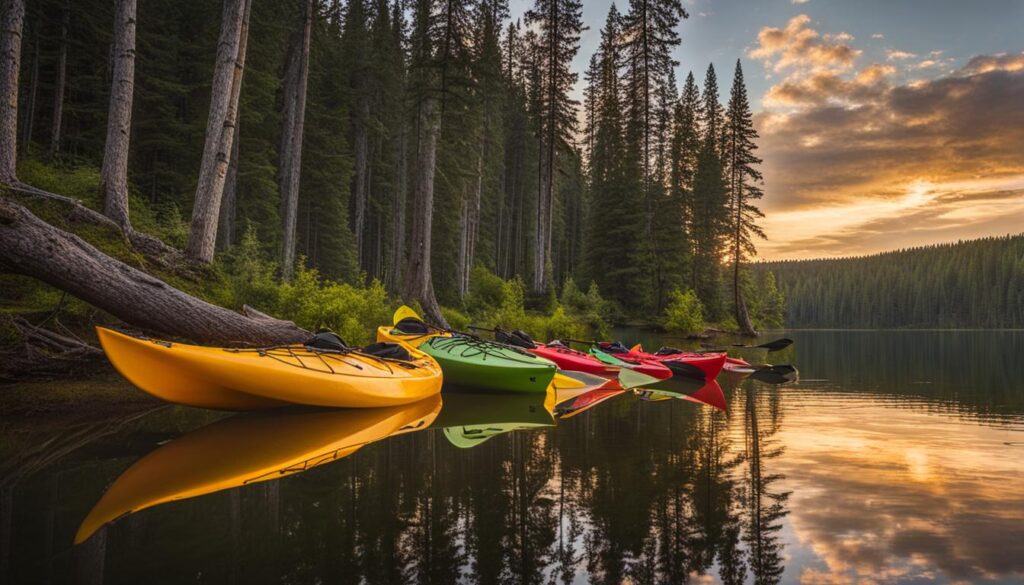
Considerations for Solo Kayak Camping
Solo kayak camping offers a unique and rewarding outdoor experience, but it also comes with its own set of considerations and challenges. Safety should always be a top priority when embarking on a solo kayak trip. It’s important to take additional precautions and be self-reliant, as there won’t be a group to rely on in case of emergencies or difficult situations.
When planning for a solo kayak camping trip, make sure to carry essential safety gear, including a personal flotation device (PFD) and a communication device such as a waterproof cell phone or a marine radio. These tools will provide you with a means to call for help if needed. Familiarize yourself with the water conditions, weather forecasts, and any potential hazards you may encounter during your trip.
While solo kayak camping requires self-reliance, it also offers the freedom to explore at your own pace and the opportunity for personal growth and self-reflection. Enjoy the tranquility of nature and take this time to reconnect with yourself. Embrace the independence and challenge of solo kayaking and create unforgettable memories as you navigate through breathtaking landscapes.
Table: Benefits of Solo Kayak Camping
| Benefits | Description |
|---|---|
| Independence | Solo kayak camping allows you to set your own pace and make decisions based on your preferences. |
| Self-Reflection | Enjoy solitude and quiet moments in nature, providing opportunities for self-growth and introspection. |
| Freedom | Explore remote locations and hidden gems without having to compromise on your itinerary. |
| Challenge | Test your skills and abilities as you navigate through different water conditions and overcome obstacles. |
“Solo kayak camping allows me to disconnect from the hustle and bustle of daily life and truly immerse myself in the beauty of nature. It’s a time for self-discovery, where I can challenge myself and build confidence. The freedom and independence that solo kayaking provides are truly unmatched.” – Kayak enthusiast
Advantages of Group Kayak Camping
Group kayak camping offers a range of advantages that can enhance your outdoor experience. One of the main benefits is the opportunity to enjoy the social aspects of camping with others. Whether you’re camping with friends, family, or a group of like-minded adventurers, group kayak camping allows you to share the experience, build camaraderie, and create lasting memories together.
Organizing a kayak camping group also provides practical benefits. By distributing responsibilities and resources among group members, camping logistics become more manageable. Tasks like setting up tents, preparing meals, and gathering firewood can be shared, making the overall camping experience more enjoyable and efficient.
Additionally, group dynamics play a significant role in group kayak camping. Being part of a group allows you to learn from each other’s skills and knowledge. You can exchange tips and tricks, share paddling techniques, and discover new camping spots through the collective wisdom of the group. This collaborative learning environment enhances the overall experience and fosters a sense of community.
“Camping is a great way to bond and connect with others. When you’re out on the water with a group of friends or family, you create a special bond that can only be formed through shared adventures and challenges.”
Overall, group kayak camping offers a unique blend of social connection, shared experiences, and practical advantages. It allows you to enjoy the beauty of nature while building relationships and creating lasting memories with others who share your love for outdoor exploration.

“Camping is not just a way to escape the daily grind; it’s an opportunity to connect with others and create lasting memories. Whether you’re camping with lifelong friends or making new ones along the way, group kayak camping provides an incredible setting for forging bonds and experiencing the beauty of nature together.”
Tips for a Successful Solo or Group Kayak Camping Trip
Whether you’re planning a solo adventure or embarking on a group kayak camping trip, proper preparation and essential tips can ensure a successful and enjoyable experience. Here are some key recommendations to consider:
Solo Kayak Camping Tips
- Plan your route and inform someone about your itinerary, including your expected return date.
- Pack essential safety gear such as a personal flotation device (PFD), a whistle, and a waterproof communication device.
- Check the weather forecast and water conditions before heading out to ensure a safe and enjoyable journey.
- Carry enough food, water, and emergency supplies to sustain yourself during your solo adventure.
- Develop basic kayaking skills and practice self-rescue techniques to handle challenging situations independently.
Group Kayak Camping Tips
- Communicate and coordinate with your group members to plan the trip, establish roles and responsibilities, and synchronize equipment.
- Assign a designated leader or experienced paddler to ensure that everyone follows safety guidelines and best practices.
- Distribute camping gear, food, and water among group members to evenly distribute the load and make it more manageable.
- Establish a system for communication and staying together on the water, such as using designated hand signals or walkie-talkies.
- Encourage all group members to take a kayaking and safety course before the trip to enhance their skills and knowledge.
Remember, whether you’re camping solo or with a group, it’s crucial to familiarize yourself with local regulations and rules, practice Leave No Trace principles, and respect the environment and wildlife around you. By following these tips, you can have a safe and memorable kayak camping experience.
Kayak Camping Essentials
| Essential Gear | Additional Considerations |
|---|---|
| Personal Flotation Device (PFD) | Ensure it fits properly and is approved by the Coast Guard. |
| Kayak and Paddle | Choose a kayak suitable for your camping needs and ensure your paddle is the correct size and type for your comfort. |
| Navigation Tools | Carry a compass, map, and/or GPS device to navigate safely and accurately. |
| First Aid Kit | Include essential medical supplies, such as bandages, antiseptics, and any personal medications. |
| Waterproof Storage | Use dry bags or waterproof containers to protect your gear and supplies from getting wet. |
| Food and Water | Pack non-perishable food items and carry an adequate supply of drinking water or water purification methods. |
| Camping Equipment | Bring a tent, sleeping bag, sleeping pad, cooking stove, and other necessary camping gear based on your needs and preferences. |
| Emergency Communication Device | Consider carrying a satellite phone, a personal locator beacon (PLB), or a waterproof VHF radio for emergencies. |
By ensuring you have the essential gear and following these tips, you’ll be well-prepared for an unforgettable kayak camping trip, whether you choose to paddle solo or enjoy the companionship of a group.
Conclusion
Whether you’re planning a solo adventure or a group excursion, both solo and group kayak camping offer their own unique advantages. Solo kayak camping allows you to embrace solitude and connect with nature on a deeper level. It’s a chance to escape the demands of everyday life and embark on a journey of self-discovery. As you paddle through serene waters and set up camp under the stars, you’ll find peace and rejuvenation in the beauty of the great outdoors.
On the other hand, group kayak camping provides an opportunity to build camaraderie and create lasting memories with friends or fellow outdoor enthusiasts. Sharing the experience with others brings a sense of community and connection. The laughter around the campfire, the stories shared, and the support offered during challenging moments foster a bond that is hard to replicate. Group camping allows you to learn from each other, grow together, and strengthen relationships.
Ultimately, the decision between solo and group kayak camping depends on your personal preferences and the goals you have for your camping trip. If you’re seeking solitude and self-reflection, solo kayak camping is a wonderful choice. If you thrive on social interaction and want to build camaraderie, group kayak camping is the way to go. No matter which option you choose, kayaking and camping in nature will provide an unforgettable experience that nourishes your soul and leaves you with cherished memories to last a lifetime.
FAQ
What are the benefits of solo kayak camping?
Solo kayak camping allows for independence and solitude in nature, providing opportunities for self-reflection and personal growth. It also allows for greater flexibility in trip planning and itinerary.
What are the benefits of group kayak camping?
Group kayak camping offers a sense of community and shared experiences, making it a great option for socializing and building camaraderie. Group camping also provides added safety and support in case of emergencies or challenging situations.
What factors should I consider when choosing a kayak for solo or group camping?
Factors to consider include where you plan to paddle (lake, river, coast), the type of kayak (sit-on-top or sit-in), the weight and budget of the kayak, and the shape and size of the kayak. These factors will impact the kayak’s performance, handling, and storage capacity.
What are the different types of kayaks available for solo and group camping?
There are various types of kayaks available, including recreational kayaks, touring kayaks, fishing kayaks, and tandem kayaks. Recreational kayaks are ideal for casual paddling on lakes and calm rivers, while touring kayaks are designed for longer trips and provide ample storage space. Fishing kayaks are specifically designed for fishing enthusiasts, with added features like rod holders. Tandem kayaks are perfect for group camping, allowing for shared paddling and increased stability.
What safety precautions should I take for solo kayak camping?
Solo kayak camping requires carrying essential safety gear, including a personal flotation device (PFD) and a communication device. It also requires self-reliance and the ability to handle challenging situations independently.
What are the advantages of group kayak camping?
Group kayak camping provides the opportunity to share the experience with others, build camaraderie, and learn from each other’s skills and knowledge. It also allows for the distribution of responsibilities and resources, making camping logistics more manageable.
What tips can you provide for a successful solo or group kayak camping trip?
Some tips for a successful kayak camping trip include planning and preparing in advance, packing necessary camping gear and supplies, considering the weather and water conditions, practicing proper kayaking and camping techniques, and being aware of safety protocols. It’s also important to communicate and coordinate with your group if you’re camping in a group.

